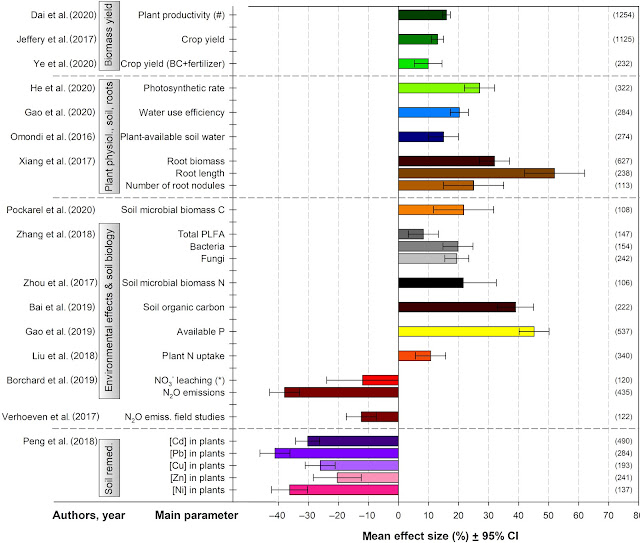I'm not sure when I got my first HOTBIN composter; I remember buying it from Tony Callaghan, inventor of the HOTBIN, before he sold the patents and company to DS Smith in January 2016. Tony then moved into biochar R&D/manufacturing with his new company SoilFixer.
What is Biochar?
The International Biochar Initiative (IBI) defines biochar as 'the solid material obtained from the thermochemical conversion of biomass in an oxygen-limited environment'. In essence, it is a form of charcoal used today mainly as a fuel for BBQs. Biomass (e.g. wood, straw, coir) heated in air is termed combustion and produces mainly water, carbon dioxide and mineral ash. When biomass is heated in an inert atmosphere (i.e. oxygen-deficient) then it is called pyrolysis and yields predominantly biochar, bio-oil and bio-gas (aka syngas). Combustion and pyrolysis both release carbon dioxide (bad!); however, the latter produces only half as much (good!).
Biochar Benefits
For the gardener/farmer/horticulturist, the most important use of biochar is as a soil improver or amendment. Qualitatively, it is acknowledged that soil health improves when biochar is added, especially when added to poor quality soils. Quantifying the benefits, in order to decide whether it is a cost-effective intervention, is more difficult because: (i) biochar is not a uniform standardized product due to variations in the biomass feed, pyrolysis conditions and post-pyrolysis processing/treatment, (ii) standardising field trials to directly compare with/without biochar is hard, and (iii) biochar is usually added as a co-mixture with compost, fertilizer, nutrients, etc.
There have been over 15,000 papers on the use of biochar in agriculture so it is, indeed, fortunate we have accesss to a meta-analysis of meta-analyses that summarise the results of all these studies. The graphic below is taken from 2021 paper by Schmidt et al. See the link to read the paper in full.
Biochar and Climate Change
How to Use Biochar
Biochar can be worked directly to the soil prior to planting but I prefer to add it to my hot composting bins. This primes the biochar with nutrients and turns it into a more effective soil amendment.
I use a 50:50 mix of Soilfixer Compost Activator (Humification Agent) and Biochar Granules (0-10mm), adding about 60 g with every 6 litres of garden/kitchen waste. An old laundry bottle cap serves as a useful measure for 60 g (see pic at top of page). The compost activator assists with the composting process and the biochar acts as a sponge for nutrients and micro-organisms. By using locally-sourced biochar (from Gloucestershire) primed/innoculated with garden compost from my garden (and some neighbours' gardens), the resulting compost is optimised for growing plants in my garden.
Is Biochar a Cost-effective Soil Amendment?
On a commercial (farming) scale, this is a very important question. If the cost is covered by increased crop yields while also improving soil health and making the soil more resilient to adverse weather events (floods & drought) then cost benefits start to accrue. Unfortunately, the cost of manufacturing biochar is currently too high for routine use on commercial farms. Scaling up biochar production should reduce prices and it would also help if the 'polluter pays principle' was universally applied by instigating a proper carbon tax (e.g. on fossil fuel-based fertilizers).
I use about 80 kg biochar products per year at a cost of around £195. This offsets my annual carbon footprint by about 250 kg (a quarter of a metric tonne) of carbon dioxide equivalent. Currently, this is much more expensive than paying into a carbon offset programme.
However, I am also benefitting from a healthier and more resilient soil, increased crop yields and reduced irrigation costs. Quantifying these benefits is difficult. Qualitatively, I know I am using less water for irrigation and crop yields seem to be higher (e.g. best onion crop ever last year).
When I originally set up the kitchen garden, I had to remove lots of waste material and rubble and then infill with bought-in topsoil (recovered soil is sieved to remove large stones/roots and mixed with sand and compost). This was a very sterile environment for growing fruit and vegetables so I have been slowly improving the soil, year-by-year, by digging in garden compost initially and, more recently, compost and biochar. Soil tilth has improved and the colour has changed from light grey to dark grey.
As the soil carbon builds up in the soil, I will reduce the amount of biochar I add to my compost. At some point, I will need to send soil samples to a laboratory for analysis.
Finally, if you are interested in learning more about biochar and its benefits, then have a look at the Soilfixer website, FAQ and blog.








0 comments:
Post a Comment